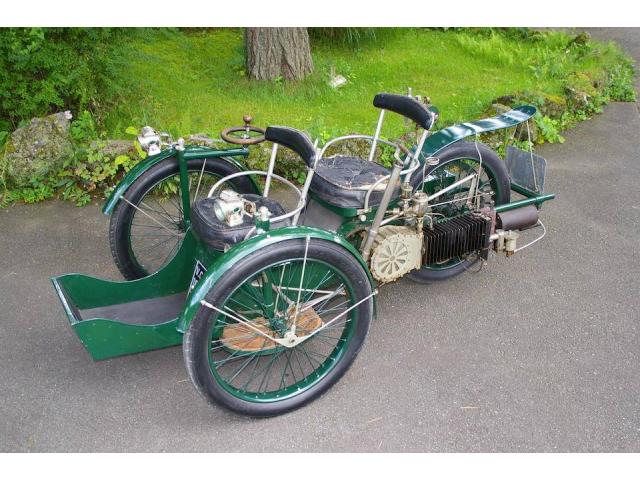1896 Léon Bollée Tandem Two-seater
- Brand: Léon Bollée
1896 Léon Bollée Tandem Two-seater
Perhaps reacting against his father’s total commitment to steam transport, young Léon Bollée saw greater potential in the internal combustion engine and designed his first such powered vehicle, a tandem two-seater, three-wheeler as early as 1895. Production was based at Le Mans and the single-cylinder, air-cooled, engine was offered in two versions developing either 2hp or 3hp, giving these machines an amazingly fast turn of speed. Three forward speeds were standard and the tubular frame owed much to bicycle manufacturing methods. Bollée’s significant invention in this machine was the driving wheel axle carried by levers pivoted on the frame of the vehicle, allowing the movement of the axle backwards or forwards to increase or release belt tension for gear changing. The engine was mounted horizontally with radiating cooling ribs and ignition was by hot tube, using an oil-fired burner, a similar system to that of Panhard-Levassor. Contemporary motor racing driver, Charles Jarrott, in his standard work, ‘Ten Years of Motors and Motor Racing’ referred to the presence of Léon Bollées at the start of the 1896 London to Brighton Run as follows –
“Léon Bollée was there, with a small fleet of those extraordinary little machines invented by him, which always, to their mind resembled land torpedoes more than anything else.” Léon and father Amédee Bollée and H.O. Duncan were to drive these vehicles in this landmark event. In 1897 Léon Bollées won The Motorcycle Cup, a major race organised and sponsored by ‘La France Automobile’, then as now qualifying for both motorcycle and car events. The Paris-Amsterdam Race, held in the same year, was won by Jamin on a Bollée, extraordinarily covering 170km in 4 hours and 13 minutes.
Today Léon Bollées are accepted for both the LBVCR and the equally prestigious Sunbeam M.C.C. Pioneer Run to Brighton. The late Sammy Davis, founder of the Veteran Car Club of Great Britain, was an energetic Léon Bollée driver and today they have a distinct appeal to more sporting sorts. This car carries a VCC dating plate recording the date of manufacture as 1896, per VCC Dating Certificate no. 319. It was found in Ipswich in poor condition in 1936 and took part in its first Brighton Run in 1953 and then again in 1954, in the hands of R.Lawson, then registered NHW 1. In later years, having lost the NHW 1 number, it belonged to VCC Past President and ‘guru’ of quirky, pioneer three wheelers, Johnnie Thomas, at some later stage going overseas. Coming now from a major overseas collector, it is very smartly presented in green livery with nickel fittings, including spring-mounted oil cycle lamps. Only four 1896 examples of this marque are listed in the current VCC of GB Members Handbook and this dating guarantees the earliest possible starting position in Hyde Park for the London to Brighton Veteran Car Run. There can be no more authentic way of re-enacting the 1896 Emancipation Run than on one of these exciting (just ask the passenger!) ‘land torpedoes’.
Descriptions & Pictures by bonhams
| Specification | |
| Production Start | 1896 |
| Country of origin | France |


























